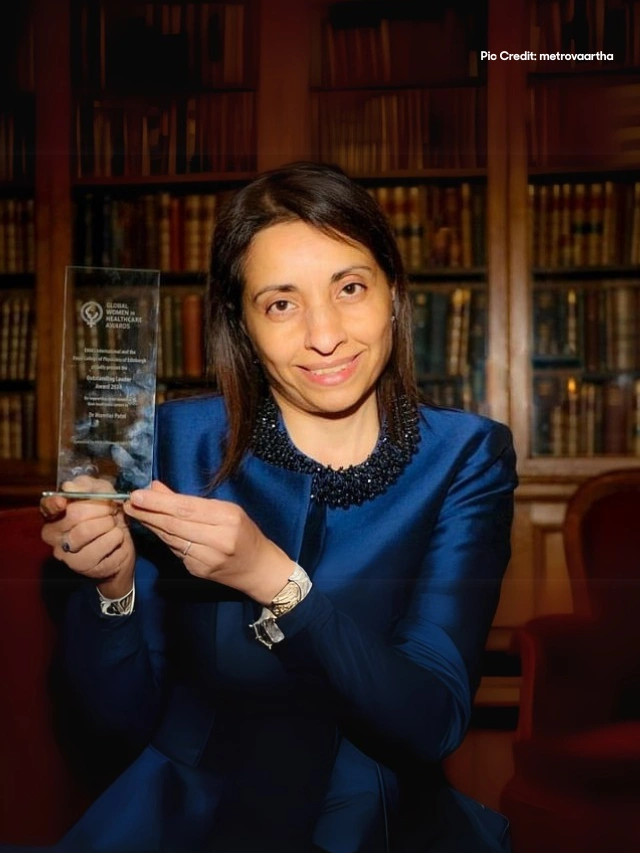
Anita Majumdar
Anita Majumdar became a powerful force in Canadian entertainment after winning the Best Actress award at the 2005 Asian Festival of First Films for her role in Murder Unveiled. She didn’t speak English until age six as her Bengali immigrant parents’ daughter, which gave her a unique viewpoint in Canadian theater and television.
CEO’s | Actors | Politicians | Sports Stars
She spent fifteen years becoming skilled at three forms of classical Indian dance – Bharata Natyam, Kathak, and Odissi. During this time, she also studied at the University of British Columbia and the National Theater School of Canada. Her commitment to performing arts resulted in acclaimed works like The Fish Eyes Trilogy. The production toured Canada and received critical recognition at prestigious venues including the PuSh International Performing Arts Festival.
Majumdar’s achievements span from being Canada’s only featured actress in Deepa Mehta’s Midnight’s Children to receiving the Governor General’s Protégé Prize in playwriting. She has proven herself as a multifaceted artist who naturally combines cultural storytelling with contemporary theater. Her path from Port Moody, British Columbia, to becoming an award-winning playwright and performer demonstrates the impact of embracing one’s cultural heritage while redefining artistic limits.
“Classical Indian dance hasn’t traditionally made a lot of room for expressing naturalistic, contemporary female anger.”

Early Life and Cultural Roots in Port Moody
Bengali heritage and family influence
Anita Majumdar was born on November 22 in Port Moody, British Columbia, to Hindu Bengali immigrants from India. Her family’s cultural background shaped both her identity and artistic work deeply. She grew up differently from other Canadian children in her mostly white hometown. Her household was rich with Bengali traditions, language, and cultural practices. This unique background helped her create art that spoke about cultural identity through her performances and writing. Her parents managed to keep strong ties to their roots. Even as she grew up in Canada, she developed a deep connection to her family’s heritage and traditions early in life.
Growing up between two cultures
Life between two distinct cultural worlds brought both challenges and opportunities to young Anita. She didn’t speak English until she turned six. At home, she spoke only her family’s native language. This experience of growing up with two languages became the foundation for her art about cultural identity. Port Moody’s small-town setting added another layer to her bicultural life. She later shared in interviews that growing up as a person of color meant she rarely saw herself in mainstream culture. “In small towns you need it the most: a kind of reflection to feel like ‘oh, I’m a part of this country. I’m a part of the fabric that makes this country,'” Majumdar explained. Her teenage years in Port Moody later inspired her trilogy of plays about high school life through a cultural lens.
Early exposure to performing arts
Classical Indian dance marked Majumdar’s first steps into performing arts. She trained extensively for over 15 years in multiple dance forms. Her formal education covered three distinct classical Indian dance styles:
- Kathak – A northern Indian classical dance form characterized by rhythmic footwork and expressive storytelling
- Bharata Natyam – One of India’s oldest classical dance traditions, known for geometric positions and spiritual themes
- Odissi – An ancient temple dance from eastern India featuring curved postures and fluid movements
Traditional dance gave her both skill and cultural connection that deeply influenced her artistic voice. Her early training became the foundation for her later works where dance told stories. She loved Western entertainment too, including Bollywood films and pop culture. This mix of Eastern classical training and Western influences created her unique artistic style that propelled her breakthrough work, Fish Eyes. She created the character of Meena, a classically trained Indian dancer who “despite being obsessed with Bollywood movies and her dance career, just wants to be like the rest of her high-school friends”. Dance became more than just training – it became her way to explore questions about cultural belonging and identity.
From Indian to the World

The Dance Foundation: Training in Classical Forms
Fifteen years of Kathak training
Anita Majumdar’s artistic trip began with a deep commitment to Kathak, one of India’s most respected classical dance forms. She spent over fifteen years learning this intricate northern Indian dance style. Kathak became her primary dance language with its precise footwork, expressive storytelling, and rhythmic complexity. She didn’t just try different art forms. Instead, she dove deep into Kathak’s technical requirements and cultural traditions. She learned its subtle hand gestures, emotional expressions, and complex rhythmic patterns. These formative years of intensive training developed her physical abilities and deepened her connection to her Bengali heritage. The discipline of Kathak training shaped how she approached all her future artistic work. It gave her the attention to detail that would become her trademark as a playwright and performer.
Expanding to Bharata Natyam and Odissi
Majumdar later added two more major classical Indian dance forms to her repertoire: Bharata Natyam and Odissi. Bharata Natyam, one of India’s oldest classical dance traditions, gave her a new movement language. This dance form features geometric positions, precise hand gestures (mudras), and spiritual themes. Odissi brought something different with its curved postures, fluid movements, and temple dance origins from eastern India. Very few professional Indian dancers master three distinct classical traditions. Majumdar didn’t just stick to traditional choreography. She started creating contemporary hybrids and fusions of these forms. She stood out in Canadian performing arts because she kept the technical authenticity while finding new ways to use these traditions. These traditional dance forms became her tools to explore modern themes and stories.
How dance shaped her artistic perspective
Dance training changed how Majumdar tells stories and performs. She explains it best: “In India there’s no formal word for ‘theater.’ When you’re speaking of theater, you mean dance. Inherent in our culture is still the sense of codification in dance movement that we’re all familiar with. It’s part of storytelling”. This blend of movement and narrative became the life-blood of her award-winning works. Her dance background shaped her theater pieces in several ways. She could express complex emotions beyond words. Her performances connected with cultural traditions that added layers of meaning. The technical precision gave her shows a unique visual power. Her works like Fish Eyes and the trilogy that followed use dance as “an essential way of learning character and action”.
The Fish Eyes Trilogy shows how dance shaped her artistic vision. Each play has main characters who work through “their real-life dilemmas through dance, while learning the heartaches of youth and the meaning of heritage”. She can create “contemporary hybrids” of classical forms. This skill made her an innovative force in Canadian theater. She created what one academic called “the emergence of a new (and specific to the performance) movement language”. Her dance foundation gave her more than just technical skill. It provided a full artistic viewpoint that helped her create works with remarkable cultural and expressive depth.
Academic Journey and Formal Theater Education
University of British Columbia experience
Building an academic foundation, Anita Majumdar started her post-secondary education at the University of British Columbia. She earned a complete Bachelor of Arts degree that combined Theater, English, and South Asian Languages. This unique mix of subjects showed her dedication to learning Western theater while staying connected to her cultural roots. Her time at UBC helped her build a rare point of view that connected performance traditions from different cultures. These university years gave her the analytical skills and literary knowledge that worked perfectly with her dance background. This foundation later shaped her unique artistic voice.
Training at the National Theater School of Canada
Following her undergraduate studies, Majumdar got into the prestigious National Theater School of Canada and joined their intensive three-year Acting Program. She graduated in 2004[141], marking a crucial step in her artistic progress. She received intensive professional training in theatrical techniques, voice, movement, and performance theory. She had a life-changing moment at the school, which she described: “It was one of those moments on stage where I could energetically feel I had earned an audience’s attention by simply being honest. Dropping the façade of ‘acting’ and really just channeling my lived experience out there for all to see”. This experience shaped her artistic approach as she found the strength of authentic cultural storytelling in theater.
Blending academic knowledge with artistic practice
After completing her formal education, Majumdar kept developing her craft through several prestigious playwright development programs. She honed her writing skills at the Tarragon Theater’s Playwright’s Unit and Cahoots Theater’s Hot House Writer’s Unit. She became a playwright-in-residence at Nightswimming and received multiple invitations to the prestigious Banff Playwright’s Lab. These opportunities helped her develop her unique voice and gain industry recognition. She later went back to school and earned a Master of Arts in Theater and Performance Studies at York University. This advanced degree deepened her understanding of performance traditions and cultural representation.
The meeting of academic training and artistic practice became Majumdar’s trademark approach to storytelling. Her education gave her the theory and skills that improved her strong dance foundation. Her works like The Fish Eyes Trilogy show how well she combined her diverse training. Majumdar’s academic path shows how she built skills across different areas. She connected traditional dance, modern theater techniques, and cultural studies. This mix of knowledge helped her create works that speak to people across cultures while staying technically strong and emotionally powerful.
The Fish Eyes Trilogy: Breakthrough as a Playwright
Creation of Fish Eyes (2004)
The artistic breakthrough came for Anita Majumdar when she created “Fish Eyes.” The play first premiered at the André Pagé Studio at the National Theater School of Canada in January 2004. Kate Schlemmer directed the original production. The play made its official debut at Toronto’s Theater Passe Muraille in October 2005. Majumdar took on dual roles as choreographer and performer. This one-woman show tells Meena’s story. She’s a classically trained Indian dancer who “despite being obsessed with Bollywood movies and her dance career, just wants to be like the rest of her high-school friends”. The play started as a solo performance and quickly earned praise for showing real teenage struggles. The show has toured Canada and other countries for many years. Schools picked it up as a way to help boost teenage girls’ self-esteem.
Boys With Cars: Learning About Cultural Identity
The second installment became part of a trilogy when Majumdar wrote “Boys With Cars.” Nightswimming commissioned and developed it under Brian Quirt’s direction. The play features Naz, a classically trained dancer from Port Moody who dreams of studying at the University of British Columbia. Her story takes an unexpected turn after Buddy sexually assaults her. Rumors and bullying follow, putting her university dreams at risk. Majumdar skillfully uses dance to show the character’s emotional trip. She blends “classical Indian, Bollywood and hip-hop music and choreography”. The play handles sexual assault and victim-blaming with subtle grace. One reviewer praised how it avoided “the didactic heavy-handedness that often lays like a dead fish over plays that treat Serious Issues”.
Let Me Borrow That Top: Completing the Trilogy
The final piece of Majumdar’s theatrical triptych came from both Nightswimming and The Banff Center. This creative segment shows Candice’s side of the story. She’s the antagonist from earlier plays. Majumdar performs “in white-face, in the style of a YouTube makeup tutorial”. She changes on stage by “putting on blue contacts, a blonde wig and applying makeup to her face to appear Caucasian”. This bold choice speaks volumes about “the pressure on women of color to appear white, and therefore have greater access to attaining privileges in everyday life”. Candice might be Naz’s tormentor, but she emerges as “equally flawed… with her own set of confused family dynamics and longing for acceptance”.
Themes and Impact of the Trilogy
The collective power of The Fish Eyes Trilogy comes from showing universal themes through culturally specific stories. Cultural appropriation stands out clearly through Candice’s fascination with bhangra and Indian dance. The trilogy tackles sexual consent, male privilege, and victim-blaming head-on. These problems gained more attention years later. Majumdar noticed something interesting during the trilogy’s run at Factory Theater in Toronto. She said “the Me Too movement just started, just tip of the iceberg”. Critics loved how the work “foreshadowed #MeToo and more mainstream conversation about consent, cultural appropriation and why some feel entitled to take whatever they want”. The trilogy shows three sides of connected events. One interviewer called it “an exercise in empathy”. It pushes audiences to see different sides of social issues that still hit home today.
Anita Majumdar Movies and TV Success
Award-winning role in Murder Unveiled
Anita Majumdar made a stunning screen debut in the 2005 CBC television film “Murder Unveiled.” She brought to life the character of Davinder Samra, based on Jaswinder Kaur Sidhu, a Canadian Sikh beautician killed by her family after she secretly married a poor Indian rickshaw driver. The role pushed her to explore complex themes of cultural conflict and honor killings. She showed remarkable skill in handling such sensitive material with genuine emotion and truth. Her compelling performance caught critics’ attention and won her Best Actress at the 2005 Asian Festival of First Films in Singapore—remarkable for her first screen role. This project came at the same time she created “Fish Eyes,” starting her career’s focus on culturally meaningful work.
Participation in Midnight’s Children
After her award-winning debut, Majumdar landed a key role in renowned director Deepa Mehta’s adaptation of Salman Rushdie’s “Midnight’s Children” in 2012. She stepped into the role of Emerald, aunt to main character Saleem Sinai and wife to General Zulfikar (played by Rahul Bose). The role tested her in unexpected ways: “Perhaps the greatest challenge was that I was a Canadian playing a girl who was born and brought up in north India during a very specific time period”. This experience made her question her cultural identity. She realized, “Up until then I had really thought myself an ‘Indian’ and then suddenly working with all these noted Indian actors it became very obvious to me that I will never fully be Indian”. She found herself amazed to work with legends like Shabana Azmi, Seema Biswas, and Rahul Bose.
Television appearances and growing recognition
Majumdar’s screen career features a rich mix of film and television roles. She appeared as Michelle Richmond in the Canadian series “Republic of Doyle” (2011). Her performances proved she could excel in both theater and screen work. She chose projects that tackled important cultural stories and challenging social issues instead of chasing mainstream success. Her screen work matched her theater performances in exploring themes of cultural identity, belonging, and immigrant life. Despite her success on screen, Majumdar’s heart remained in theater: “What I didn’t realize was that my soul is in theater, that my voice is heard through theater”.
Key Achievements of Anita Majumdar
Television Success
Received the Best Actress Award at the Asian Festival of First Films (2005) for her role as Davinder Samra in the CBC film Murder Unveiled.
Theater Excellence
Created the acclaimed “Fish Eyes Trilogy” (Fish Eyes, Boys with Cars, and Let Me Borrow That Top), exploring cultural identity and personal challenges. Won Dora Mavor Moore Awards (2017) for Outstanding New Play and Outstanding Performance for Boys with Cars.
Film Recognition
Played Emerald in Deepa Mehta’s adaptation of Salman Rushdie’s Midnight’s Children (2012), demonstrating her versatility as an actress.
Cultural Impact
Integrated her training in classical Indian dance into her storytelling, bringing South Asian narratives to Canadian theater and global audiences.
Impact on the Industry
Anita Majumdar has significantly influenced the Canadian arts industry by amplifying South Asian voices and narratives, bringing cultural diversity to the forefront of theater and performance. Through her acclaimed works, such as the Fish Eyes Trilogy, she has shed light on the complexities of identity, immigration, and the experiences of young women navigating cultural duality. Her ability to blend classical Indian dance forms with contemporary storytelling has enriched Canadian theater with unique perspectives and artistic depth.
Beyond her performances, Majumdar has mentored emerging playwrights, fostering a new generation of talent that prioritizes inclusion and authenticity. By receiving major accolades such as the Dora Mavor Moore Awards, she has set a benchmark for excellence in culturally rooted storytelling. Her work has paved the way for greater representation of marginalized voices in mainstream art forms, influencing how diverse stories are told on stage and screen in Canada and beyond.
Giving Back
Anita Majumdar is deeply committed to nurturing the next generation of artists and storytellers. She actively mentors emerging playwrights, sharing her expertise and encouraging them to embrace their cultural identities in their work. By doing so, she fosters a creative space where underrepresented voices can thrive and contribute to a richer, more inclusive arts landscape.
In addition to mentoring, Majumdar participates in initiatives that promote diversity and inclusion in the performing arts. Her work not only entertains but also educates audiences about the challenges and triumphs of immigrant communities, inspiring dialogue and understanding. Through her continued engagement with community-driven projects and her commitment to authentic storytelling, she exemplifies the spirit of giving back to the artistic and cultural community.
Key Takeaways
Cultural Storytelling
Majumdar’s work highlights the importance of authentic representation, bringing South Asian narratives and immigrant experiences to the forefront of Canadian arts.
Blending Art Forms
She integrates classical Indian dance with modern storytelling, creating a unique fusion that enriches theater and engages diverse audiences.
Trailblazer for Diversity
By addressing themes of identity, gender, and cultural conflict, her contributions have opened doors for greater inclusion in mainstream theater and film.
Mentorship and Legacy
Anita actively mentors young artists and playwrights, fostering a community of creators who prioritize inclusivity and authenticity.
Recognition and Influence
Her accolades, such as the Dora Mavor Moore Awards, underscore her impact on the industry, setting a high standard for culturally nuanced storytelling.
Global Indian Impact Analysis

FAQ:
What is Anita Majumdar's net worth?
Anita Majumdar’s exact net worth is not publicly disclosed. However, her career as a successful actress, playwright, and dancer, coupled with her awards and extensive contributions to Canadian theater and film, suggests a commendable professional standing. Her work in critically acclaimed productions such as the Fish Eyes Trilogy and her roles in films and television add to her reputation and influence in the industry.
What is known about Anita Majumdar’s family?
Anita Majumdar was born to Bengali immigrant parents in Port Moody, British Columbia, Canada. Her family’s cultural heritage has deeply influenced her works, which often explore the themes of identity and the immigrant experience. While she keeps her personal life relatively private, her family’s support for her passion in dance, theater, and storytelling played a significant role in shaping her career.
What is Anita Majumdar’s nationality?
Anita Majumdar is Canadian. She was born and raised in Port Moody, British Columbia, to parents of Bengali origin. Her works often reflect the blend of her Canadian upbringing and South Asian heritage, bringing a unique perspective to her storytelling in theater and film.
Is Anita Majumdar married?
Anita Majumdar has kept her personal life private, and there is no publicly available information confirming her marital status or spouse. She is known for focusing on her professional journey as an artist, playwright, and mentor.
What is Anita Majumdar’s educational background?
Anita Majumdar earned a Bachelor of Arts degree in Theatre, English, and South Asian Languages from the University of British Columbia. She later graduated from the National Theatre School of Canada in 2004, further honing her skills as an actress and playwright. She also has over 20 years of training in classical Indian dance forms like Kathak, Odissi, and Bharatanatyam.
What awards has Anita Majumdar received?
Anita Majumdar has earned several accolades, including the Best Actress award at the 2005 Asian Festival of First Films for Murder Unveiled. In 2017, she won Dora Mavor Moore Awards for Outstanding New Play and Outstanding Performance for Boys with Cars, part of her acclaimed Fish Eyes Trilogy.
How old is Anita Majumdar?
Anita Majumdar was born in 1984, making her 39 years old as of 2024. She has built an impressive career spanning nearly two decades, with accomplishments in theater, film, and dance.
What was Anita Majumdar’s first film?
Anita Majumdar’s first major film was the CBC television film Murder Unveiled (2005), in which she played Davinder Samra. Her performance earned her critical acclaim and the Best Actress award at the Asian Festival of First Films, marking a significant milestone in her career.





